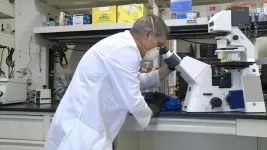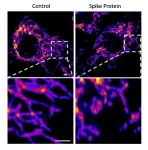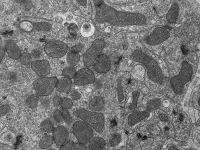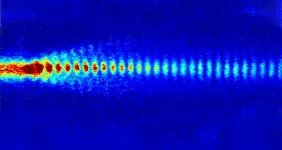Researchers develop chip that improves testing and tracing for COVID-19
2021-04-30
(Press-News.org) Jeremy Edwards, director of the Computational Genomics and Technology (CGaT) Laboratory at The University of New Mexico, and his colleagues at Centrillion Technologies in Palo Alto, Calif. and West Virginia University, have developed a chip that provides a simpler and more rapid method of genome sequencing for viruses like COVID-19.
Their research, titled, "Highly Accurate Chip-Based Resequencing of SARS-CoV-2 Clinical Samples" was published recently in the American Chemical Society's Langmuir. As part of the research, scientists created a tiled genome array they developed for rapid and inexpensive full viral genome resequencing and applied their SARS-CoV-2-specific genome tiling array to rapidly and accurately resequenced the viral genome from eight clinical samples acquired from patients in Wyoming that tested positive for SARS-CoV-2. Ultimately, they were able to sequence 95 percent of the genome of each sample with greater than 99.9 percent accuracy.
"This new technology allows for faster and more accurate tracing of COVID and other respiratory viruses, including the appearance of new variants," said Edwards, who is a professor in the UNM Department of Chemistry and Chemical Biology. "With this simple and rapid testing procedure, scientists will be able to more accurately track the progression and better prevent the onset of the next pandemic."
With more than 142 million people worldwide having contracted the virus, vigilant testing and contact tracing are the most effective ways to slow the spread of COVID-19. Traditional methods of clinical testing often produce false positives or negatives, and traditional methods of sequencing are time-consuming and expensive. This new technology will virtually eliminate all of these barriers.
"Since the submission of the paper, the technology has further evolved with improved accuracy and sensitivity," said Edwards. "The chip technology is the best available technology for large-scale viral genome surveillance and monitoring viral variants. This technology could not only help control this pandemic and also prevent future pandemics."
The mission of the Computational Genomics and Technology (CGaT) Laboratory is to provide training in bioinformatics research for undergraduate, master's and Ph.D. students, as well as postdoctoral fellows; provide collaborative research interactions to utilize bioinformatics computing tools for researchers at UNM, and to conduct state-of-the-art and innovative bioinformatics and genomics research within the center.
INFORMATION:
[Attachments] See images for this press release:

ELSE PRESS RELEASES FROM THIS DATE:
2021-04-30
Boston, MA (April 30, 2021) - A new study, presented today at the AATS 101st Annual Meeting, shows that non-invasive cell-free DNA tests can reduce the need for regular surveillance biopsies to detect early rejection in heart transplant patients. The study was the first of its kind to be performed on both adult and pediatric patients.
Pediatric and adult heart transplant recipients were recruited prospectively from eight participating sites and followed longitudinally for at least 12 months with serial plasma samples collected immediately prior to all endomyocardial biopsies. Structured biopsy results and clinical data were collected and monitored by an independent clinical research organization (CRO).
For ...
2021-04-30
Boston, MA (April 30, 2021) - A new study, presented today at the AATS 101st Annual Meeting, found that severely ill COVID-19 patients treated with ECMO did not suffer worse long-term outcomes than other mechanically-ventilated patients. The multidisciplinary team included cardio thoracic surgeons, critical care doctors, medical staff at long-term care facilities, physical therapists and other specialists, and followed patients at five academic centers: University of Colorado; University of Virginia; University of Kentucky; Johns Hopkins University; and Vanderbilt University. ...
2021-04-30
LA JOLLA--(April 30, 2021) Scientists have known for a while that SARS-CoV-2's distinctive "spike" proteins help the virus infect its host by latching on to healthy cells. Now, a major new study shows that they also play a key role in the disease itself.
The paper, published on April 30, 2021, in Circulation Research, also shows conclusively that COVID-19 is a vascular disease, demonstrating exactly how the SARS-CoV-2 virus damages and attacks the vascular system on a cellular level. The findings help explain COVID-19's wide variety of seemingly unconnected complications, and could ...
2021-04-30
While the CRISPR-Cas9 gene editing system has become the poster child for innovation in synthetic biology, it has some major limitations. CRISPR-Cas9 can be programmed to find and cut specific pieces of DNA, but editing the DNA to create desired mutations requires tricking the cell into using a new piece of DNA to repair the break. This bait-and-switch can be complicated to orchestrate, and can even be toxic to cells because Cas9 often cuts unintended, off-target sites as well.
Alternative gene editing techniques called recombineering instead perform this bait-and-switch ...
2021-04-30
Medical researchers at Flinders University have established a new link between high body mass index (BMI) and breast cancer survival rates - with clinical data revealing worse outcomes for early breast cancer (EBC) patients and improved survival rates in advanced breast cancer (ABC).
In a new study published in a top breast cancer journal- researchers evaluated data from 5 thousand patients with EBC and 3496 with ABC to determine associations between BMI and survival rates across both stages.
Researchers say the results present an 'obesity paradox' which will impact the survival outcomes of the 19,807 women and 167 men diagnosed with breast cancer in Australia in 2020.
Natansh Modi, a NHMRC PHD Candidate at Flinders University, says understanding the ...
2021-04-30
The Brazilian Amazon rainforest released more carbon than it stored over the last decade - with degradation a bigger cause than deforestation - according to new research.
More than 60% of the Amazon rainforest is in Brazil, and the new study used satellite monitoring to measure carbon storage from 2010-2019.
The study found that degradation (parts of the forest being damaged but not destroyed) accounted for three times more carbon loss than deforestation.
The research team - including INRAE, the University of Oklahoma and the University of Exeter - said large areas of rainforest were degraded or destroyed due to human activity and climate change, leading to carbon loss.
The findings, published in Nature Climate Change, also ...
2021-04-30
Mitochondria are the energy suppliers of our body cells. These tiny cell components have their own genetic material, which triggers an inflammatory response when released into the interior of the cell. The reasons for the release are not yet known, but some cardiac and neurodegenerative diseases as well as the ageing process are linked to the mitochondrial genome. Researchers at the Max Planck Institute for Biology of Ageing and the CECAD Cluster of Excellence in Ageing research have investigated the reasons for the release of mitochondrial genetic material and found a direct link to cellular metabolism: when the cell's DNA building blocks are in short supply, mitochondria release their genetic material and trigger inflammation. ...
2021-04-30
Scientists at the University of Nottingham have developed an ultrasonic imaging system, which can be deployed on the tip of a hair-thin optical fibre, and will be insertable into the human body to visualise cell abnormalities in 3D.
The new technology produces microscopic and nanoscopic resolution images that will one day help clinicians to examine cells inhabiting hard-to-reach parts of the body, such as the gastrointestinal tract, and offer more effective diagnoses for diseases ranging from gastric cancer to bacterial meningitis.
The high level of performance the technology delivers is currently only possible in state-of-the-art research labs with large, scientific instruments - whereas this compact system has the potential to bring it into clinical settings to improve patient care.
The ...
2021-04-30
Successful navigation requires the ability to separate memories in a context-dependent manner. For example, to find lost keys, one must first remember whether the keys were left in the kitchen or the office. How does the human brain retrieve the contextual memories that drive behavior? J.B. Julian of the Princeton Neuroscience Institute at Princeton University, USA, and Christian F. Doeller of the Max Planck Institute for Human Cognitive and Brain Sciences in Leipzig, Germany, found in a recent study that modulation of map-like representations in our brain's hippocampal formation can predict contextual memory retrieval in an ambiguous environment.
The researchers developed a novel virtual reality navigation task in which human participants learned object positions in two different ...
2021-04-30
The future of particle acceleration has begun. Awake is a promising concept for a completely new method with which particles can be accelerated even over short distances. The basis for this is a plasma wave that accelerates electrons and thus brings them to high energies. A team led by the Max Planck Institute for Physics now reports a breakthrough in this context. For the first time, they were able to precisely time the production of the proton microbunches that drive the wave in the plasma. This fulfills an important prerequisite for using the Awake technology for collision experiments.
How do you create a wave for electrons? The carrier substance for this is a plasma (i.e., an ionized gas in which positive and negative charges are separated). Directing a proton beam through ...
LAST 30 PRESS RELEASES:
[Press-News.org] Researchers develop chip that improves testing and tracing for COVID-19






